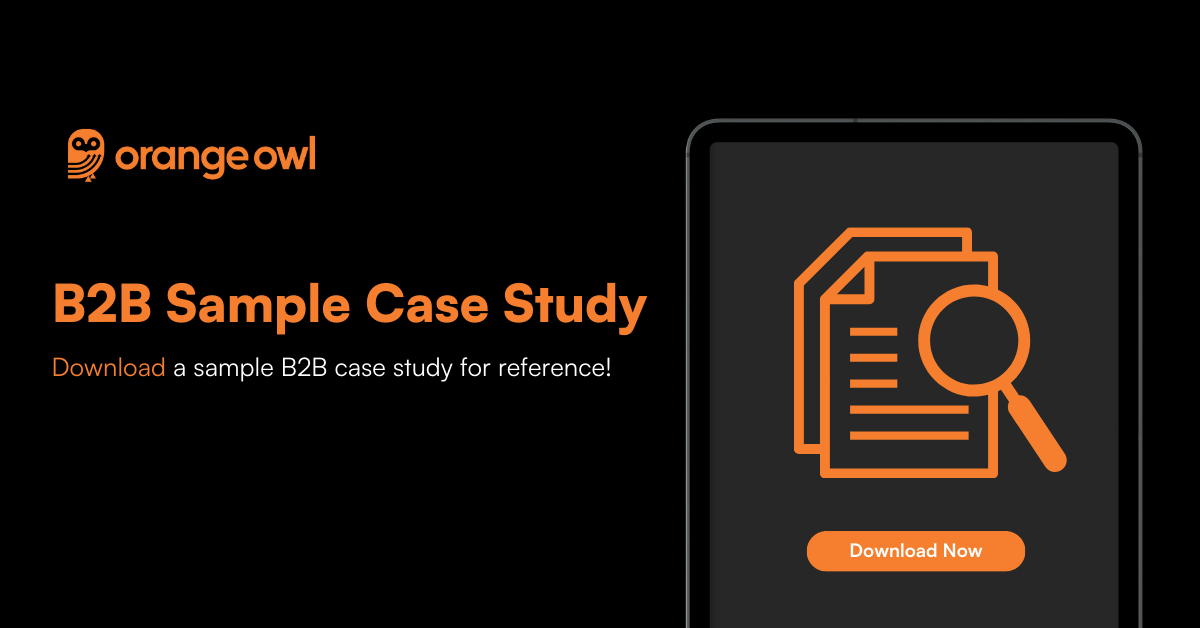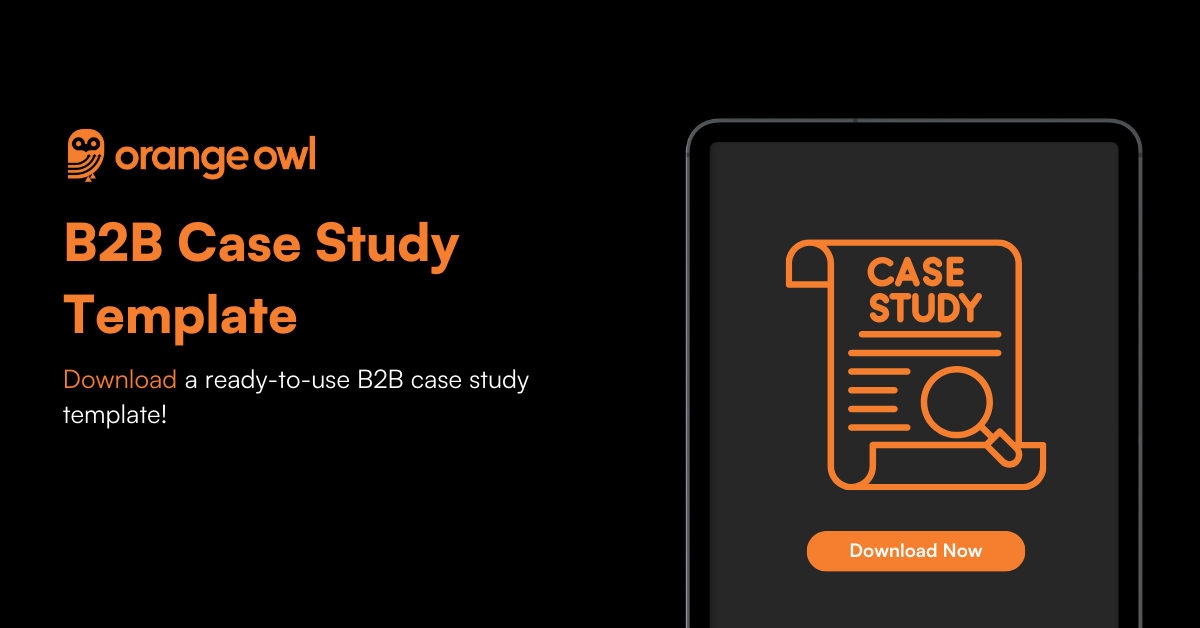The Power of Case Studies in B2B Marketing: The Ultimate Guide
Vivek Goel
April 2, 2025
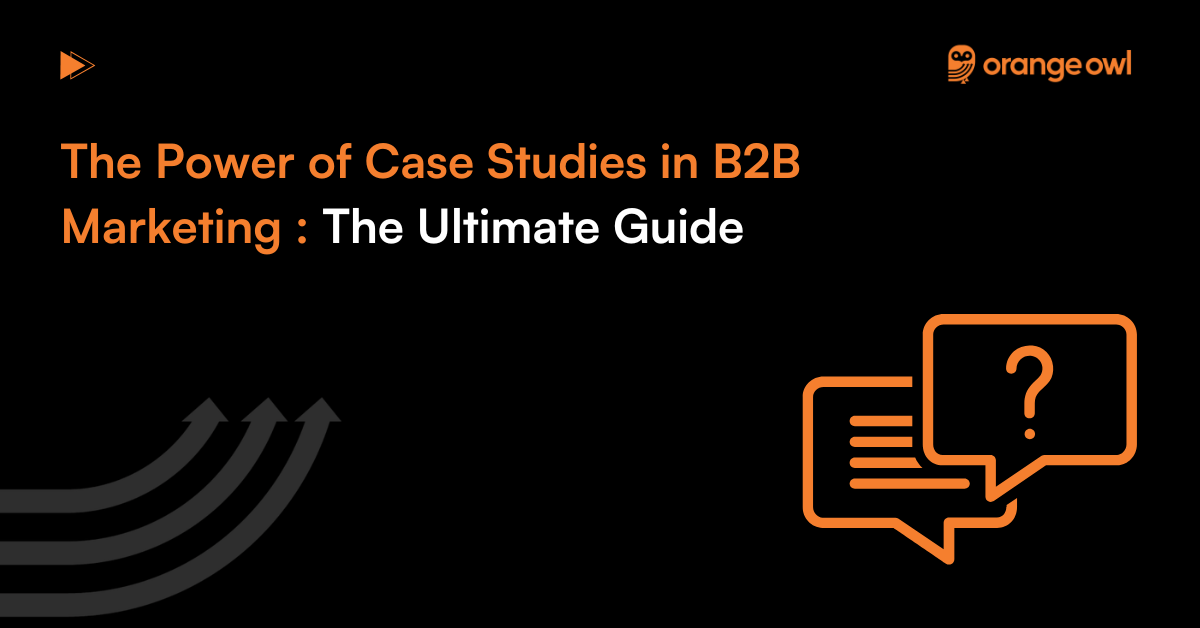
Table of Contents
Introduction
Case studies in B2B marketing have become essential in today’s competitive landscape, helping companies stand out and earn the trust of potential clients. Unlike traditional advertising, these real-world success stories showcase how a product or service effectively solved a specific business problem. They offer powerful narratives that highlight a company’s expertise, credibility, and proven ability to deliver measurable outcomes.
B2B marketing plays a crucial role in this process, as it focuses on building long-term relationships, addressing complex buyer journeys, and providing data-driven insights that influence purchasing decisions. According to the Content Marketing Institute, 73% of B2B marketers use case studies as part of their content strategy, making them one of the most widely used formats for lead generation and customer engagement.
Additionally, a study by Demand Gen Report found that 79% of B2B buyers consider case studies essential when researching a purchase decision. Businesses operate in an environment where decision-makers require tangible proof before committing to a purchase. A well-crafted B2B marketing strategy leverages case studies to go beyond marketing claims, demonstrating through detailed accounts how a solution has worked for similar businesses. Whether it’s improving efficiency, increasing revenue, or enhancing customer satisfaction, case studies in B2B Marketing act as persuasive evidence that can sway potential clients, making them a cornerstone of effective B2B marketing.
What are Case Studies in B2B Marketing?
A case study in B2B marketing is a detailed, real-world success story showcasing how a business product or service solved a specific problem for another business. It serves as a powerful proof point that helps potential clients understand the impact and effectiveness of a solution through tangible results. Unlike traditional marketing materials, which often focus on general claims, case studies provide evidence-based storytelling to build credibility and influence decision-makers.
Key Aspects of a B2B Case Study
1. Demonstrates Real-World Application
B2B buyers seek practical solutions that align with their unique challenges. A case study illustrates how a product or service was implemented in a real business scenario, making it easier for prospects to visualize how it could work for them.
✅ Example: A SaaS company publishes a case study on how its automation software reduced processing time by 40% for a manufacturing client.
2. Builds Trust and Credibility
Case studies offer social proof, showing that other businesses have successfully used a product or service. This reassures potential clients that they are making a data-backed and low-risk decision.
✅ Example: A cybersecurity firm highlights how it helped a financial institution prevent cyberattacks, showcasing expertise and reliability.
3. Provides Data-Driven Results
Unlike generic marketing content, case studies emphasize quantifiable outcomes, making them more persuasive. Numbers and statistics strengthen the impact of the success story.
✅ Example: A logistics software provider reports that its routing solution helped a retail chain cut fuel costs by 25% and delivery time by 30%.
4. Supports Different Stages of the Buyer’s Journey
- Awareness Stage: Educates potential customers about common industry challenges.
- Consideration Stage: Shows how a specific solution has worked for others.
- Decision Stage: Provides the final push to convince decision-makers to purchase.
✅ Example: A cloud storage company shares case studies addressing cost reduction, security, and scalability, appealing to different decision-makers (e.g., CIOs, CFOs).
5.Highlights Competitive Differentiation
A well-crafted case study not only shows success but also explains why a particular solution was chosen over competitors. This helps businesses stand out in a crowded market.
✅ Example: A CRM provider demonstrates how its platform’s AI-driven insights led to a 50% increase in sales conversions compared to traditional CRM solutions.
6.Enhances Sales and Lead Generation
Case studies act as highly effective sales enablement tools, helping sales teams convert leads into customers. They can be shared in presentations, proposals, email campaigns, and social media to engage potential buyers.
✅ Example: A marketing agency showcases how its SEO strategy boosted organic traffic by 30% for a B2B client, encouraging new prospects to inquire about similar services.
Why Are Case Studies Important in B2B Marketing?
Case studies are an essential tool in B2B marketing as they offer real-world validation of a company’s products or services. In a market where buyers seek evidence-based decision-making, case studies provide the proof needed to gain trust, establish authority, and influence purchasing behaviour. Unlike generic marketing materials, case studies showcase how a solution has delivered measurable success for other businesses, making them a powerful persuasion tool.
1.Reduces Perceived Risk for Buyers
B2B purchases are often high-stakes, involving long-term commitments and significant investments. Decision-makers are cautious and require assurance that a solution will work before making a purchase. Case studies help mitigate risk by showing how other companies have successfully implemented the solution.
✅ Example:
A manufacturing company looking to adopt AI-driven quality control systems reads a case study on how another manufacturer reduced product defects by 40%, reassuring them that the investment is worthwhile.
2.Serves as a Powerful Negotiation Tool
In B2B sales, price negotiations and contract discussions are common. A well-crafted case study provides concrete proof of ROI (Return on Investment) and operational benefits, making it easier for sales teams to justify pricing and secure deals.
✅ Example:
An enterprise software company provides a case study showing how its automation platform reduced operational costs by $500,000 annually for a logistics client, helping the sales team defend premium pricing during negotiations.
3.Highlights Industry-Specific Use Cases
B2B buyers often look for solutions tailored to their specific industry challenges. A generic marketing pitch may not be enough, but a case study focusing on industry-specific pain points makes the solution more relatable and compelling.
✅ Example:
A fintech startup targeting banks and financial institutions creates case studies showcasing how its fraud detection system reduced fraudulent transactions by 30% for a major bank, demonstrating its effectiveness for the finance industry.
4.Facilitates Multi-Stakeholder Buy-In
In B2B transactions, multiple decision-makers—CEOs, CFOs, IT heads, procurement teams, and end-users—are involved. Case studies provide persuasive evidence that different stakeholders can relate to, helping streamline the decision-making process.
✅ Example:
An HR software provider creates different case studies:
- For HR managers: How the software improved employee engagement.
- For CFOs: How it reduced recruitment costs by 25%.
- For IT teams: How it integrated seamlessly with existing systems.
By addressing multiple perspectives, case studies accelerate approvals and shorten the sales cycle.
5.Enhances Post-Sales Customer Confidence
Case studies aren’t just for attracting new customers—they also reinforce trust among existing clients. Sharing real-world success stories reassures customers that they made the right decision and encourages them to explore additional solutions.
✅ Example:
A SaaS company offers follow-up case studies showing how long-term clients expanded their usage of the platform, reinforcing product value and encouraging upselling and renewals.
6.Helps in Winning RFPs and Tenders
B2B companies frequently compete for large contracts through Requests for Proposals (RFPs) or tenders. Case studies act as proof of past success, increasing the chances of securing high-value deals.
✅ Example:
An IT consulting firm submits case studies in its RFP response, showcasing how it successfully implemented ERP systems for other Fortune 500 companies, giving them an edge over competitors.
7.Strengthens Employer Branding & Talent Attraction
Beyond attracting clients, case studies can also boost employer branding by showcasing a company’s impact. Potential employees want to work for companies that deliver real results and innovate in their industry.
✅ Example:
A B2B AI startup publishes case studies on how it helped companies achieve AI-driven transformation, attracting top-tier engineers and data scientists eager to work on cutting-edge projects.
8.Improves Search Engine Optimization (SEO) & Online Visibility
Publishing case studies on a website enhances SEO rankings, driving organic traffic and attracting leads searching for industry-specific solutions.
✅ Example:
A cloud solutions provider writes a case study titled “How [Company X] Reduced IT Costs by 40% with Cloud Migration”. The article ranks on Google for “cloud migration case study,” bringing in inbound leads.
9.Differentiates from New Market Entrants
In highly competitive industries, new players enter the market frequently. Case studies serve as a competitive moat, demonstrating a company’s experience and proven track record compared to newer, unproven competitors.
✅ Example:
An established cybersecurity firm publishes case studies showing how it protected government agencies and Fortune 500 firms, differentiating itself from new, untested competitors.
10.Creates Long-Lasting Marketing Assets
Unlike ads that have a limited shelf life, case studies remain valuable marketing assets for years. They can be repurposed into presentations, blogs, whitepapers, videos, and webinars, maximizing their ROI.
✅ Example:
A B2B logistics company turns a case study into:
- A LinkedIn post highlighting key stat.
- A blog post with in-depth analysis.
- A video interview with the client.
- A sales brochure for conferences.
By repurposing case studies across channels, businesses maximize exposure and lead generation.
Key Components of an Effective B2B Case Study
A well-structured B2B case study is a powerful storytelling tool that persuades potential clients by demonstrating real-world success. To be effective, it should be clear, data-driven, and engaging, guiding the reader through a compelling journey from challenge to resolution. Below are the key components of a strong B2B case study, along with expert tips and real-world examples to enhance impact.
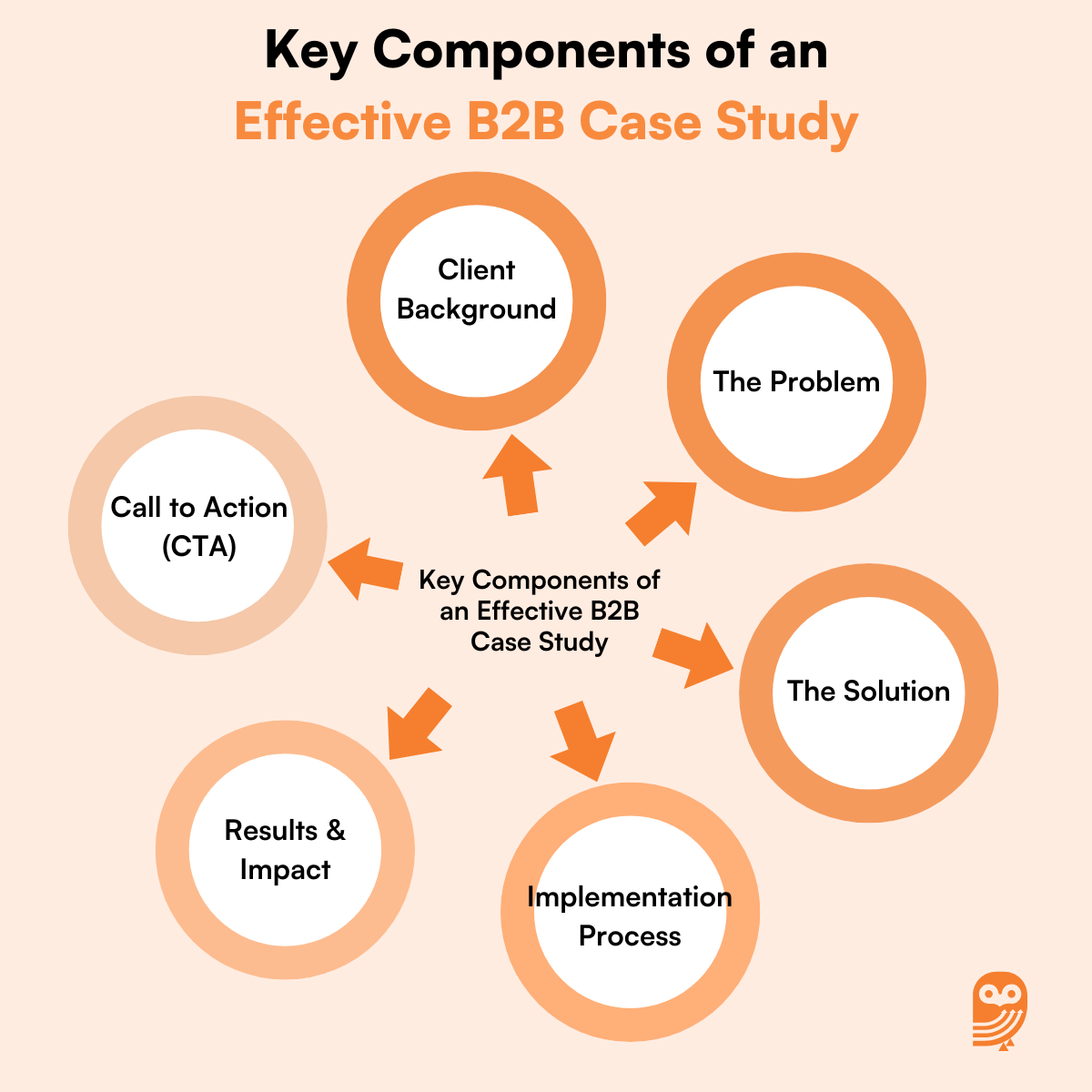
1. Client Background
Introduce the client by providing a brief overview of their business, industry, and key objectives. This helps potential customers relate to the case study by identifying similarities between their business and the featured client.
Key Elements to Include:
✅ Company name (or industry, if anonymity is required)
✅ Industry & market position
✅ Size & location
✅ Business objectives before seeking a solution
Expert Tip:
Keep the introduction concise and relevant. Avoid excessive details about the client’s history—focus instead on what makes them an ideal subject for the case study.
Example:
Company: XYZ Logistics
Industry: Supply Chain Management
Background: XYZ Logistics is a mid-sized supply chain firm managing shipments across North America. Facing increasing fuel costs and delayed deliveries, they sought a technology-driven solution to optimize routes and reduce operational expenses.
2.The Problem
Clearly define the pain points the client faced before using your solution. This section should outline challenges, inefficiencies, and business risks that led them to seek an alternative.
Key Elements to Include:
✅ Specific problems and their impact on business performance
✅ Attempts to solve the problem before choosing your solution
✅ Urgency or critical nature of the issue
Expert Tip:
Use direct quotes or statements from the client to emphasize their frustration or urgency. This makes the problem more authentic and relatable.
Example:
XYZ Logistics struggled with inefficient routing and high fuel costs, leading to 30% delivery delays. Their existing route-planning system lacked real-time tracking, increasing costs and frustrating customers.
📌 Client Quote:
“Our delivery times were inconsistent, and customers were losing trust in us. We needed a smarter way to optimize routes and control costs.”
3.The Solution
Detail how your product or service directly addressed the client’s challenges. This section should focus on the unique features and competitive advantages of your offering.
Key Elements to Include:
✅ The specific solution provided
✅ Features of the product/service that solved the problem
✅ Why the client chose your company over competitors
Expert Tip:
Use visuals, screenshots, or diagrams to explain technical solutions clearly, especially for SaaS or tech-based products.
Example:
XYZ Logistics implemented AI-powered route optimization software, which provided:
🚀 Real-time GPS tracking for dynamic adjustments
🚀 Fuel efficiency analytics, reducing unnecessary mileage
🚀 Automated delivery scheduling, improving consistency
“We chose this solution because it integrated with our existing fleet management system without major disruptions.”
4.Implementation Process
Explain how the solution was integrated into the client’s operations. This helps potential buyers understand the transition process, especially if they are concerned about implementation complexity.
Key Elements to Include:
✅ Steps taken to implement the solution
✅ Timeframe of deployment
✅ Challenges encountered and how they were resolved
Expert Tip:
Showcase a seamless implementation to reassure future clients that the adoption process will be smooth. If challenges arose, highlight how they were resolved quickly.
Example:
XYZ Logistics onboarded the new system in three phases over eight weeks:
1️. Pilot Test (Week 1-2): Deployed in one regional hub to measure impact.
2️. Full Implementation (Week 3-6): Rolled out across all delivery routes.
3️. Optimization (Week 7-8): Fine-tuned AI algorithms based on real-world data.
🚀 Challenge: Initial staff resistance to the new system.
✅ Solution: Conducted on-site training and provided real-time support to drivers.
5.Results & Impact
This is the most persuasive part of the case study—use hard data to showcase the effectiveness of your solution. Highlight before-and-after comparisons, increased efficiency, revenue growth, or cost savings.
Key Elements to Include:
✅ Measurable business impact (revenue, efficiency, cost reduction)
✅ Client testimonials or direct quotes
✅ Before-and-after data
Expert Tip:
Use charts, infographics, and side-by-side comparisons to visually emphasize improvements.
Example:
After implementing the AI-powered routing software, XYZ Logistics achieved:
📈 20% reduction in fuel costs within three months
📈 35% improvement in on-time deliveries
📈 15% increase in customer retention due to better service
📌 Client Testimonial:
“We saw an immediate improvement in our delivery performance. The AI-driven system allowed us to optimize routes in ways we never thought possible.”
6.Call to Action (CTA)
Encourage potential customers to take the next step by providing a clear call to action at the end of the case study.
Key Elements to Include:
✅ Contact details or demo request
✅ Link to related resources (whitepapers, eBooks, videos)
✅ Option for a free trial or consultation
Expert Tip:
Make the CTA clear and actionable. Avoid vague statements like “Contact us for more information.” Instead, provide a specific next step.
Example:
🚀 Want to achieve similar results? Book a free consultation today to see how AI-powered logistics can optimize your operations.
How to Create a High-Impact Case Study
A well-crafted B2B case study serves as a powerful sales and marketing tool, offering real-world proof of your product or service’s effectiveness. To create an engaging and persuasive case study, follow these five key steps:
Choose the Right Client
Not all clients make for great case studies. Selecting the right customer can significantly impact engagement and credibility.
1.How to Choose the Right Client:
✅ A client that belongs to your target audience’s industry.
✅ A company with a strong, relatable pain point and a compelling transformation.
✅ A recognizable brand (if possible) to boost credibility.
✅ A client who is satisfied and willing to share their story.
Expert Tip:
Seek clients who have seen measurable improvements after using your product and are enthusiastic about sharing their experience.
Example:
A B2B SaaS company selling customer support automation software might choose a growing e-commerce brand that struggled with slow response times and high support costs before implementing the solution.
📌 Why this client is ideal?
- Their problem (slow response times) is relatable to other e-commerce businesses.
- Their brand is well-known in the industry, adding credibility.
- The transformation was significant, making it a compelling success story.
2.Define the Problem Clearly
The case study must emphasize the pain points and challenges that led the client to seek a solution. This step is crucial because potential buyers relate to these challenges, making them more invested in the outcome.
How to Define the Problem Effectively:
✅ Clearly describe the specific challenges the client faced.
✅ Explain the impact of these challenges on their operations, revenue, or efficiency.
✅ If relevant, mention previous unsuccessful attempts to solve the problem.
Expert Tip:
Use data and direct client quotes to make the pain points feel more authentic.
Example:
A mid-sized retail company was experiencing:
🚨 30% increase in abandoned carts due to slow customer service response times.
🚨 Overloaded support staff, leading to poor customer experiences.
🚨 Declining customer retention because of unsatisfactory service.
📌 Client Quote:
“We were struggling to keep up with customer inquiries, and our team was overwhelmed. We knew we needed a better system, but we didn’t know where to start.”
3.Focus on Measurable Outcomes
To make your case study compelling, focus on quantifiable results that demonstrate the real impact of your solution.
How to Showcase Measurable Outcomes:
✅ Use data, numbers, and before-and-after comparisons to highlight improvements.
✅ Show key performance indicators (KPIs) such as revenue growth, efficiency gains, or cost savings.
✅ Include customer testimonials that validate the results.
Expert Tip:
Visualizing results with charts, graphs, and tables makes the improvements more impactful.
Example:
🚀 Customer Service Response Time Reduced by 50%
🚀 Cart Abandonment Rate Dropped by 25%
🚀 Customer Satisfaction Score (CSAT) Increased from 3.5 to 4.8
📌 Client Quote:
“Within three months of implementation, our support team became more efficient, and our customer satisfaction scores improved drastically.”
4.Structure It for Easy Reading
A well-structured case study keeps readers engaged and makes key takeaways easy to digest.
How to Improve Readability:
✅ Use subheadings (e.g., “The Problem,” “The Solution,” “The Results”).
✅ Break down content into short paragraphs, bullet points, and numbered lists.
✅ Incorporate bold text and callouts to highlight critical information.
✅ Use visual elements like infographics, before-and-after comparisons, and client photos.
Expert Tip:
Keep the case study concise (1-2 pages max) to maintain engagement. If necessary, create a short version and a detailed version for different audiences.
Example Format:
✅ Client Overview – Background, industry, and key challenges.
✅ The Problem – Specific pain points and their impact.
✅ The Solution – How the product/service solved the issue.
✅ Implementation – How the client adopted the solution.
✅ The Results – Measurable improvements and testimonials.
✅ Call to Action – Encouraging prospects to take the next step.
5.Incorporate Storytelling Elements
A great case study goes beyond facts—it tells a compelling story that captures the reader’s attention and makes the transformation memorable.
How to Add Storytelling Elements:
✅ Begin with a relatable problem (like a hero’s struggle).
✅ Show the journey of overcoming challenges with your solution.
✅ Use real client experiences and quotes to make it personal.
✅ End with a success transformation, showing the “before” and “after.”
Expert Tip:
Follow a narrative arc (Problem → Solution → Transformation) to keep readers engaged.
Example:
📌 Storytelling in Action:
“Imagine losing thousands of potential customers every month simply because your team can’t respond fast enough. That’s exactly what happened to [Client Name]. With support tickets piling up, customers were walking away. But after implementing [Solution], they turned things around. Within three months, response times improved by 50%, abandoned carts decreased by 25%, and their customer satisfaction scores hit an all-time high.”
Best Practices for Writing a Case Study
1.Make it Client-Centric
A case study should focus on the client’s journey, challenges, and success rather than just promoting your company. Highlight their experience, using direct quotes and measurable results to make the story relatable and credible. A client-centric approach builds trust and positions your company as a problem solver rather than just a service provider.
2.Keep it Concise and Clear
B2B decision-makers value clarity and efficiency. Avoid unnecessary jargon, complex explanations, or lengthy paragraphs. Structure the content with subheadings, bullet points, and concise sentences to improve readability. Ensure the language is straightforward while maintaining professionalism.
3.Use Visuals to Support the Story
Visual elements such as infographics, charts, and images enhance readability and reinforce key insights. Since decision-makers process visual information quickly, incorporating graphs, workflow diagrams, or performance snapshots makes the case study more engaging and impactful.
4.Ensure Authenticity
Trust is key in B2B marketing. Use real data, direct client quotes, and verifiable results to add credibility. If exact figures cannot be disclosed, percentage improvements or relative metrics can still demonstrate success without compromising confidentiality. Transparent storytelling, including challenges faced, makes the case study more compelling.
5.Include a Strong Conclusion
A strong conclusion should summarize key takeaways and prompt action. Reinforce the impact of the solution and encourage the reader to take the next step—whether that’s reaching out for more information, exploring similar success stories, or engaging with your business.
Key Challenges Businesses Face When Creating Case Studies in B2B Marketing
1.Difficulty Collecting Data
One of the biggest challenges in creating a case study is gathering accurate and detailed data. Many clients are hesitant to share their internal metrics due to confidentiality concerns, competitive sensitivity, or internal policies restricting data disclosure. Without access to precise numbers and performance indicators, it becomes difficult to showcase the full impact of the solution provided.
2.Lack of Client Participation
Securing the client’s cooperation in providing information, testimonials, and approvals can be a time-consuming process. Many businesses have strict policies that require multiple layers of approval before publicizing their success stories. In other cases, clients may not have the time or inclination to participate, delaying the case study’s completion.
3.Overly Promotional Tone
A common mistake in case studies is making them sound like direct advertisements rather than authentic success stories. A case study should focus on how the client benefited from the solution, rather than just promoting the company’s offerings. If the content is too sales-driven, it loses credibility and can deter potential customers from engaging with it.
4.Not Highlighting Clear Results
Without measurable outcomes, a case study lacks impact and credibility. If the success story does not provide concrete evidence of improvements, readers may struggle to see the value in the solution. Vague claims such as “improved efficiency” or “boosted sales” are not persuasive unless backed by quantifiable data.
Common Pitfalls in Writing B2B Case Studies & How to Overcome Them
1.Lack of Concrete Data
Pitfall: Many businesses hesitate to share specific performance metrics due to confidentiality concerns or a lack of concrete data. This results in vague case studies that fail to demonstrate measurable success, making them less persuasive. Without solid numbers, potential clients may find it difficult to gauge the actual impact of the solution.
Solution:
- Always strive to include quantifiable results such as percentage growth, revenue increase, cost savings, productivity improvements, or efficiency gains.
- If exact figures cannot be disclosed, use relative metrics (e.g., “increased sales by 3x”) or generalized performance indicators (“significant improvement in customer engagement”).
- Anonymize sensitive data while still showcasing the effectiveness of the solution.
- Use before-and-after comparisons or benchmarking against industry standards to add credibility.
2.Making the Case Study Too Generic
Pitfall: A one-size-fits-all approach can make case studies feel impersonal or irrelevant to different industries. If the challenges and solutions discussed do not resonate with a specific audience, the impact of the case study diminishes.
Solution:
- Tailor case studies to specific industries by highlighting challenges and solutions that are relevant to that sector.
- Use industry-specific terminology and real-world examples to make the case study relatable.
- If applicable, create multiple versions of a case study, each customized to a particular industry (e.g., one for manufacturing, one for IT, etc.).
- Interview clients to get insights on how industry dynamics played a role in their decision-making process.
3.Overly Promotional Tone
Pitfall: Some case studies read more like advertisements rather than objective business narratives. Excessive self-promotion makes them feel biased and reduces credibility, making potential clients skeptical of the results.
Solution:
- Keep the focus on the client’s journey rather than just your product or service.
- Use a third-party perspective—include direct client quotes and testimonials to provide an unbiased viewpoint.
- Use a storytelling approach rather than listing product features. Describe how the client identified a challenge, evaluated options, chose a solution, and achieved success.
- Instead of boasting about your company’s greatness, let the results and data speak for themselves.
4.Poor Storytelling & Structure
Pitfall: Case studies that are disorganized, overly technical, or too dense with information can lose reader interest. If the narrative is unclear, potential clients may struggle to connect with the story.
Solution:
- Use a clear and logical structure:
- Introduction (background of the client)
- Challenge (the problem they faced)
- Solution (how your product or service helped)
- Results (quantifiable outcomes)
- Conclusion (key takeaways and next steps)
- Use a conversational yet professional tone to keep readers engaged.
- Instead of presenting dry data, frame it as a success story—make it compelling and easy to digest.
- Keep paragraphs concise and break down information into bullet points or short sections where necessary.
5.Neglecting Visual Enhancements
Pitfall: Case studies that are text-heavy without visual elements can be difficult to digest. Long paragraphs without breaks can overwhelm the reader, reducing engagement and comprehension.
Solution:
- Incorporate visual elements such as:
- Infographics to summarize key insights
- Charts and graphs to represent performance metrics
- Images and screenshots to illustrate the solution in action
- Client logos to add credibility
- Use bolding, bullet points, and spacing to make key takeaways stand out.
- If possible, create a video case study alongside the written version for more engaging content.
Best Practices with Actionable Tips & Tools
1.Keep the Narrative Engaging
Tip: Use storytelling techniques to maintain reader interest. Focus on the client’s journey, highlighting challenges, solutions, and results.
Tool: Grammarly – Helps refine readability and tone.
2.Incorporate Data & Visuals
Tip: Use real statistics and visuals like charts and infographics to add credibility and improve engagement.
Tool: Canva – Ideal for creating infographics and visual elements.
3.Format for Easy Consumption
Tip: Break content into clear sections, use bullet points, and keep paragraphs concise for better readability.
Tool: Hemingway Editor – Helps simplify and clarify text.
4.Leverage SEO Best Practices
Tip: Optimize for relevant keywords, use headers, and include internal links to improve visibility.
Tool: Yoast SEO – Assists with keyword optimization and readability.
5.Make It Actionable
Tip: End with a strong CTA that encourages further engagement, such as scheduling a demo or downloading a resource.
Tool: HubSpot – Helps create CTAs and lead capture forms.
Leveraging Case Studies Across Marketing Channels
1.Website: Feature Them in a Dedicated Section
A well-organized case study section on your website helps potential clients easily access success stories. Consider categorizing case studies by industry, business size, or problem solved to make them more relevant to different audiences. Adding client logos, testimonials, and downloadable PDFs can enhance engagement.
2.Social Media: Share Success Snippets
Sharing key takeaways, client quotes, or compelling statistics from case studies on platforms like LinkedIn, Twitter, and Facebook can boost engagement. Short video clips or carousel posts summarizing success stories can attract more attention. Tagging clients (with their permission) can also increase reach and credibility.
3.Email Campaigns: Use Them for Lead Nurturing
Incorporating case studies in email marketing helps move prospects through the sales funnel. Sending targeted case studies relevant to a lead’s industry or pain points can increase conversion rates. Including a strong call to action, such as booking a demo, can drive further engagement.
4.Sales Collateral: Include Them in Presentations
Sales teams can use case studies in presentations, proposals, and brochures to strengthen their pitches. Providing prospects with real-world success stories during sales conversations builds trust and helps overcome objections by showcasing proven results.
5.Webinars & Events: Use Them as Discussion Points
Case studies make great discussion topics for webinars, conferences, and industry events. Presenting real success stories during a webinar or panel discussion helps illustrate your company’s impact, making it easier to connect with potential clients. Including case studies in speaker presentations can add credibility and make sessions more engaging.
Do’s and Don’ts of Writing Case Studies in B2B Marketing
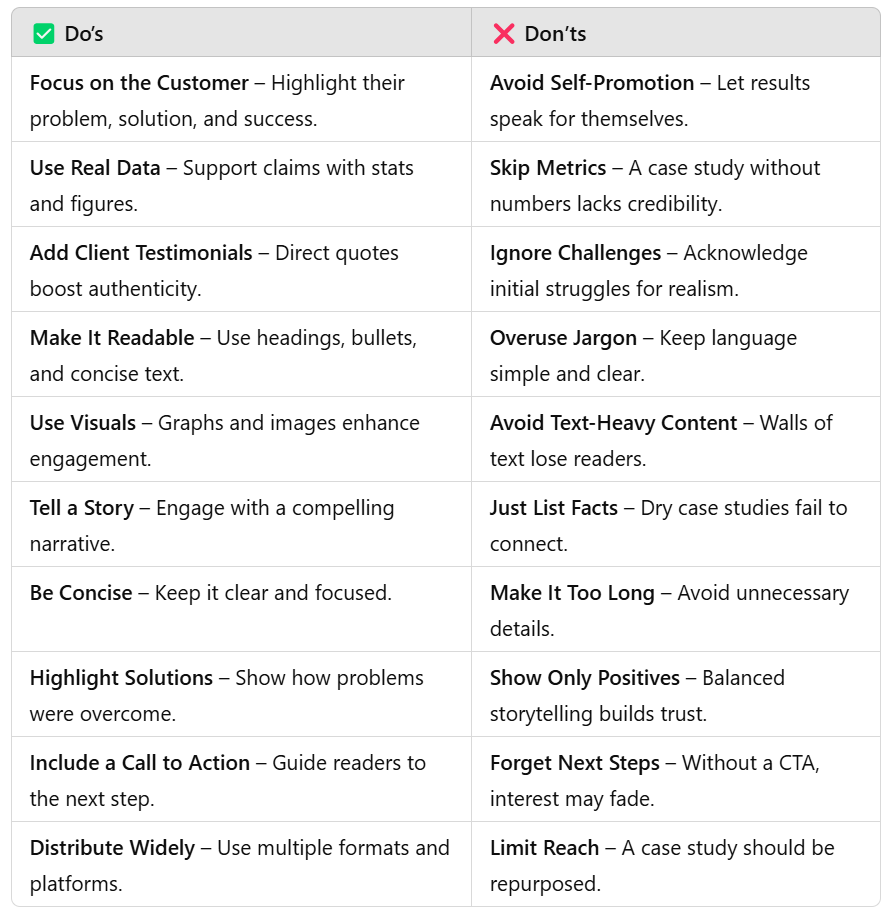
Conclusion
Case studies in B2B marketing provide tangible proof of a product or service’s effectiveness. Unlike traditional promotional content, case studies offer real-world applications by showcasing how businesses have successfully addressed specific challenges using a particular solution.
This not only builds trust but also provides potential customers with concrete insights into problem-solving strategies. Decision-makers in the B2B space rely on factual data and proven results before making purchasing decisions, and case studies serve as a credible source of validation.
Beyond their role in establishing credibility, case studies are versatile marketing assets that can be leveraged across multiple channels. They can be featured on websites to attract inbound leads, shared on social media to engage a wider audience, included in email campaigns for lead nurturing, and incorporated into sales presentations to support negotiations.
By structuring case studies in B2B Marketing effectively and using storytelling techniques to make them compelling, businesses can maximize their impact, drive conversions, and create long-term value in their marketing strategy.
Frequently Asked Questions(FAQs) on Case Studies in B2B Marketing
A case study should ideally be between 1-2 pages (500-800 words). It needs to be concise yet detailed enough to showcase the client’s challenge, solution, and measurable results. A longer case study may lose reader engagement, while a very short one might lack depth. Keep the content structured with clear headings and bullet points for easy readability. Focus on the most impactful insights to make it compelling.
It’s best to review and update case studies at least once a year to keep them relevant. If the client has seen further success or expanded their use of your solution, include those updates. Outdated data can reduce credibility, so ensure metrics and testimonials remain accurate and fresh. If industry trends shift, you may need to revise the content to reflect current market conditions. Regular updates also help keep your content engaging for new prospects.
Case studies are valuable across various B2B industries, including SaaS, manufacturing, finance, healthcare, and consulting. They work particularly well in industries where decision-makers need proof of success before making a purchase. Businesses selling high-value products or services can use them to build credibility and trust. Industries with long sales cycles also benefit as case studies help nurture leads. Any sector where problem-solving is key can leverage case studies effectively.
Select a client who faced a significant challenge that your product or service successfully addressed. The ideal client should have measurable results to showcase the impact of your solution. Choose a business that aligns with your target audience so potential customers can relate to their experience. A recognizable brand or an industry leader can add extra credibility to the case study. Ensure the client is willing to share their story publicly for maximum impact.
Yes, if confidentiality is required, you can create an anonymous case study while maintaining credibility. Instead of using the company’s name, describe them in general terms, such as “a leading SaaS provider” or “a global manufacturing firm.” Use real data and performance improvements to ensure authenticity. Some clients may agree to disclosure if you obtain proper approvals in advance. Always respect their privacy and legal considerations when publishing case studies.
Third-person narration is the preferred format for professional B2B case studies as it maintains an objective and formal tone. However, first-person can be used effectively within client testimonials to make them more personal and engaging. A mix of both can work well—for example, use third-person for the case study body and first-person for direct client quotes. This structure ensures clarity while adding a human touch to the success story. Always keep the tone professional yet relatable.
Yes, case studies can be transformed into multiple formats to maximize reach and engagement. They can be turned into blog posts, social media content, email campaigns, videos, and infographics. Sales teams can use them as part of pitch decks and proposals to demonstrate past success. A well-crafted case study can also be featured in webinars, whitepapers, or press releases. Repurposing the content helps businesses get more value from a single case study.
Start by explaining the mutual benefits—a case study provides them with positive exposure and a professional write-up. Offer to showcase their brand and highlight their success story to a wider audience. Reassure them that they will have final approval before publication to ensure accuracy. Some clients may agree in exchange for additional perks, such as co-marketing opportunities or backlinks. Always respect their decision and provide an option for anonymity if needed.
Both approaches have advantages depending on your marketing strategy. A publicly available case study increases brand awareness and makes it easier for potential clients to access. Gating the case study behind a lead capture form helps generate qualified leads but may reduce readership. A good strategy is to offer a preview or summary for free while requiring sign-up for the full version. Test different approaches to see which works best for your audience and goals.
Your website should be the primary platform for publishing case studies, ideally in a dedicated “Success Stories” section. Share them on LinkedIn, industry forums, and email campaigns to reach a wider audience. Sales teams can use them in pitches and presentations to provide real-world proof of success. Repurpose case studies into slide decks, PDFs, or video testimonials for different marketing channels. Maximizing distribution ensures your case studies reach the right decision-makers.

